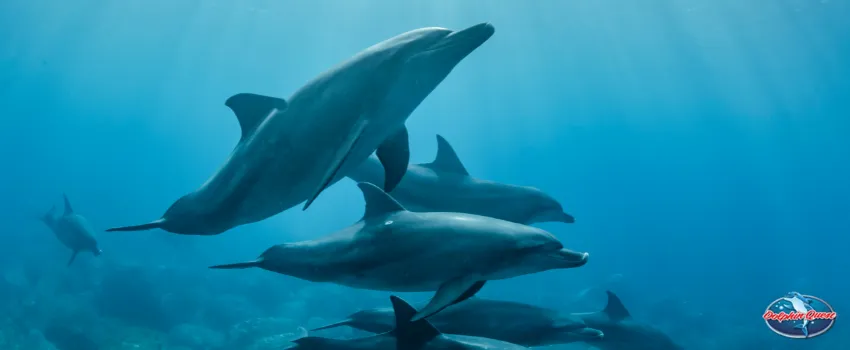Dolphins are one of the world’s most famous creatures, drawing attention from tourists, scientists, and everyone. This multi-faceted mammal displays a variety of traits that make them as popular as they are, from their cheeky playfulness to their sleek beauty.
In the wild, their most important trait is intelligence. From hunting to rearing young, a dolphin’s brain packs a lot of power. Here’s everything you need to know about dolphins that can enrich your next dolphin cruise!
The 5 Distinct Characteristics of Dolphins
Dolphins, often celebrated for their intelligence and grace, possess distinct characteristics that make them stand out in the vast marine world:
- Intelligence – Dolphins have long been celebrated for their exceptional cognitive abilities. Their problem-solving skills are astounding, and they even exhibit tool use in their daily lives.
- Playfulness – Dolphins are known for their playful behavior, often seen leaping out of the water, riding waves, and playing with other members of their pods.
- Social Behavior – Dolphins are not solitary ocean wanderers but social beings. They form close-knit groups and engage in cooperative hunting ventures and intricate social interactions.
- Streamlined Bodies – Nature has sculpted dolphins for life in the water. Their sleek, streamlined shape is designed for speed and maneuverability, allowing them to glide through the water effortlessly.
- Blowholes – Located on the tops of their heads, blowholes are a distinctive feature of dolphins. These specialized openings enable them to breathe without fully surfacing.
Masters of the Marine Realm
Dolphins have long fascinated researchers with their exceptional cognitive abilities. Their brains are large and highly developed, boasting complex structures that are strikingly similar to those of humans. Dolphins also have one of the highest brain-to-body size ratios in the animal kingdom.
One of the most remarkable facts about dolphin intelligence is their problem-solving ability. Dolphins exhibit impressive problem-solving skills, both in the wild and in captivity. They can navigate complex environments, collaborate with other dolphins to accomplish tasks, and even use tools in some instances.
For instance, dolphins in Shark Bay, Australia, use marine sponges to shield their snouts when searching for food on the ocean floor. This highlights their cleverness and adaptability.
Another compelling aspect of dolphin intelligence is their capacity for self-awareness. Some studies suggest that dolphins can recognize themselves in mirrors, a trait shared with only a few other species, such as humans, great apes, and elephants. This self-awareness suggests a level of consciousness and self-perception that is not common among animals.
The Complex Language of Dolphins
Using a combination of vocalizations, body language, and even echolocation to convey information to each other, a dolphin’s communication skills are crucial for their survival and social cohesion.
One of the most striking features of dolphin communication is their use of a series of clicks and whistles. These sounds serve various purposes, from establishing contact with other dolphins to conveying emotional states and coordinating group activities. Each dolphin has its unique signature whistle, akin to a name, which allows them to identify themselves to others in their pod. Dolphins begin learning these so-called signature whistles while still in the womb.
Dolphins are also known to engage in cooperative hunting, where they work together to catch prey. Their ability to communicate and coordinate during these hunting endeavors is awe-inspiring. They use vocalizations to signal their intentions, share information about the location of prey, and synchronize their movements for a successful hunt.
Echolocation, a remarkable ability possessed by many cetaceans, including dolphins, enables them to “see” their environment by emitting high-frequency sounds and interpreting the echoes. This skill is particularly useful for hunting and navigating in the murky depths of the ocean. Dolphins can create detailed mental maps of their surroundings through echolocation, showcasing their advanced sensory capabilities.
Social Creatures of The Sea
Beyond their intelligence, communication, and habitat, dolphins exhibit numerous other fascinating traits and behaviors, including social structures. Dolphins are highly social animals and often form tight-knit groups called pods. Depending on the species, these pods can range in size from a few individuals to several hundred members.
As mentioned earlier, some dolphin species undertake extensive migrations in search of food. These journeys can span thousands of miles and showcase their incredible navigation abilities.
Despite their remarkable abilities, dolphins face numerous threats, including habitat degradation, pollution, and bycatch in fishing nets. Many conservation efforts are underway to protect these intelligent creatures and their marine ecosystems. Even given a dolphin’s intelligence, it will take human intelligence to prevent them from disappearing from the world’s oceans.
Navigators of the Vast Oceans
Dolphins are highly adaptable creatures that inhabit a wide range of marine environments, from coastal water to the deep ocean. Their habitat choice is often influenced by their species, diet, and social structure.
Coastal dolphins, such as Atlantic bottlenose dolphins, are commonly found in the shallow waters along coastlines. These dolphins are known for their acrobatics and frequent interactions with humans. They inhabit areas where the ocean meets the land, offering them access to a variety of prey species.
In Boca Ciega Bay, our local population is Atlantic bottlenose dolphins. This population is unique in the dolphin world because they do not migrate from these relatively warm waters.
Pelagic dolphins, on the other hand, are true oceanic wanderers. Species like the common dolphin and the spinner dolphin prefer the deep water of the open ocean. They have evolved to thrive in these vast and challenging environments, where they can encounter different prey species and travel long distances searching for food.
Some dolphins are even known to migrate seasonally, following the movement of their preferred prey. For instance, the orca, or killer whale, is a type of dolphin that embarks on epic migrations in search of seals and other marine mammals.
The relationship between dolphins and their habitat is intricate and deeply interconnected. They have evolved a remarkable set of physical and behavioral adaptations to thrive in their chosen environments, including streamlined bodies for efficient swimming, specialized diets, and sophisticated hunting techniques.
Key Takeaway
Dolphins are truly exceptional creatures that continue to captivate our imagination and deepen our understanding of the natural world. Their intelligence, communication skills, adaptability to diverse habitats, and a myriad of other fascinating traits make them one of the most cherished and admired animals in the oceans.
As we uncover facts about dolphins and work to protect these remarkable marine mammals, we discover new layers of their complexity and their vital role in the marine ecosystem.
Get ready for a dolphin adventure of knowledge and awe with Sunshine Scenic Tours.
Ever been curious about the hidden wonders beneath the waves and the vibrant dolphins of Boca Ciega Bay? Your adventure begins with Sunshine Scenic Tours! Board the Dolphin Quest on Madeira Beach today for an eco-educational journey, coming face-to-face with these magnificent marine creatures.









